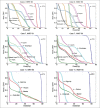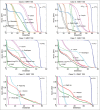Dosimetric differences in flattened and flattening filter-free beam treatment plans
- PMID: 27217620
- PMCID: PMC4871009
- DOI: 10.4103/0971-6203.181636
Dosimetric differences in flattened and flattening filter-free beam treatment plans
Abstract
This study investigated the dosimetric differences in treatment plans from flattened and flattening filter-free (FFF) beams from the TrueBeam System. A total of 104 treatment plans with static (sliding window) intensity-modulated radiotherapy beams and volumetric-modulated arc therapy (VMAT) beams were generated for 15 patients involving three cancer sites. In general, the FFF beam provides similar target coverage as the flattened beam with improved dose sparing to organ-at-risk (OAR). Among all three cancer sites, the head and neck showed more important differences between the flattened beam and FFF beam. The maximum reduction of the FFF beam in the mean dose reached up to 2.82 Gy for larynx in head and neck case. Compared to the 6 MV flattened beam, the 10 MV FFF beam provided improved dose sparing to certain OARs, especially for VMAT cases. Thus, 10 MV FFF beam could be used to improve the treatment plan.
Keywords: Flattening filter-free beam; intensity-modulated radiotherapy; treatment plan.
Figures


Similar articles
-
Dosimetric Comparison of Unmatched Flattening Filter-free and Flattened Beams in Volumetric Arc Therapy Plans for Head-and-neck Cancer.J Med Phys. 2023 Oct-Dec;48(4):338-344. doi: 10.4103/jmp.jmp_68_23. Epub 2023 Dec 5. J Med Phys. 2023. PMID: 38223791 Free PMC article.
-
Flattening Filter-Free Beams in Intensity-Modulated Radiotherapy and Volumetric Modulated Arc Therapy for Sinonasal Cancer.PLoS One. 2016 Jan 6;11(1):e0146604. doi: 10.1371/journal.pone.0146604. eCollection 2016. PLoS One. 2016. PMID: 26734731 Free PMC article.
-
Flattening filter free in intensity-modulated radiotherapy (IMRT) - Theoretical modeling with delivery efficiency analysis.Med Phys. 2019 Jan;46(1):34-44. doi: 10.1002/mp.13267. Epub 2018 Nov 20. Med Phys. 2019. PMID: 30371944
-
Effects of flattening filter-free and volumetric-modulated arc therapy delivery on treatment efficiency.J Appl Clin Med Phys. 2013 Nov 4;14(6):4328. doi: 10.1120/jacmp.v14i6.4328. J Appl Clin Med Phys. 2013. PMID: 24257275 Free PMC article.
-
A dosimetric evaluation of flattening filter-free volumetric modulated arc therapy in nasopharyngeal carcinoma.J Med Phys. 2014 Jul;39(3):150-5. doi: 10.4103/0971-6203.139003. J Med Phys. 2014. PMID: 25190993 Free PMC article.
Cited by
-
Lymphocyte-Sparing Radiotherapy: The Rationale for Protecting Lymphocyte-rich Organs When Combining Radiotherapy With Immunotherapy.Semin Radiat Oncol. 2020 Apr;30(2):187-193. doi: 10.1016/j.semradonc.2019.12.003. Semin Radiat Oncol. 2020. PMID: 32381298 Free PMC article. Review.
-
Evidence-Based Planning Target Volume Margin Reduction for Modern Lung Stereotactic Ablative Radiation Therapy Using Deformable Registration.Adv Radiat Oncol. 2021 Jul 3;6(6):100750. doi: 10.1016/j.adro.2021.100750. eCollection 2021 Nov-Dec. Adv Radiat Oncol. 2021. PMID: 34401609 Free PMC article.
-
Dosimetric comparison of IMRT, VMAT, and hybrid techniques in stereotactic body radiotherapy for adrenal metastases.Sci Rep. 2025 Jul 1;15(1):20623. doi: 10.1038/s41598-025-06707-1. Sci Rep. 2025. PMID: 40594399 Free PMC article.
-
Stereotactic Body Radiotherapy (SBRT) of Pancreatic Cancer-A Critical Review and Practical Consideration.Biomedicines. 2022 Oct 4;10(10):2480. doi: 10.3390/biomedicines10102480. Biomedicines. 2022. PMID: 36289742 Free PMC article. Review.
-
Quality of life in early breast cancer patients after adjuvant accelerated partial-breast irradiation (APBI) in randomized trial.Sci Rep. 2025 Jan 9;15(1):1387. doi: 10.1038/s41598-025-85342-2. Sci Rep. 2025. PMID: 39779797 Free PMC article. Clinical Trial.
References
-
- Yu CX. Intensity-modulated arc therapy with dynamic multileaf collimation: An alternative to tomotherapy. Phys Med Biol. 1995;40:1435–49. - PubMed
-
- Mackie TR, Holmes T, Swerdloff S, Reckwerdt P, Deasy JO, Yang J, et al. Tomotherapy: A new concept for the delivery of dynamic conformal radiotherapy. Med Phys. 1993;20:1709–19. - PubMed
-
- Cahlon O, Hunt M, Zelefsky MJ. Intensity-modulated radiation therapy: Supportive data for prostate cancer. Semin Radiat Oncol. 2008;18:48–57. - PubMed
-
- Followill D, Geis P, Boyer A. Estimates of whole-body dose equivalent produced by beam intensity modulated conformal therapy. Int J Radiat Oncol Biol Phys. 1997;38:667–72. - PubMed
-
- Cashmore J, Ramtohul M, Ford D. Lowering whole-body radiation doses in pediatric intensity-modulated radiotherapy through the use of unflattened photon beams. Int J Radiat Oncol Biol Phys. 2011;80:1220–7. - PubMed
LinkOut - more resources
Full Text Sources
Other Literature Sources

